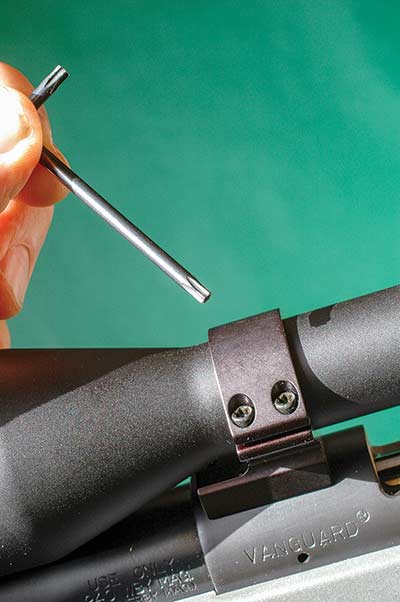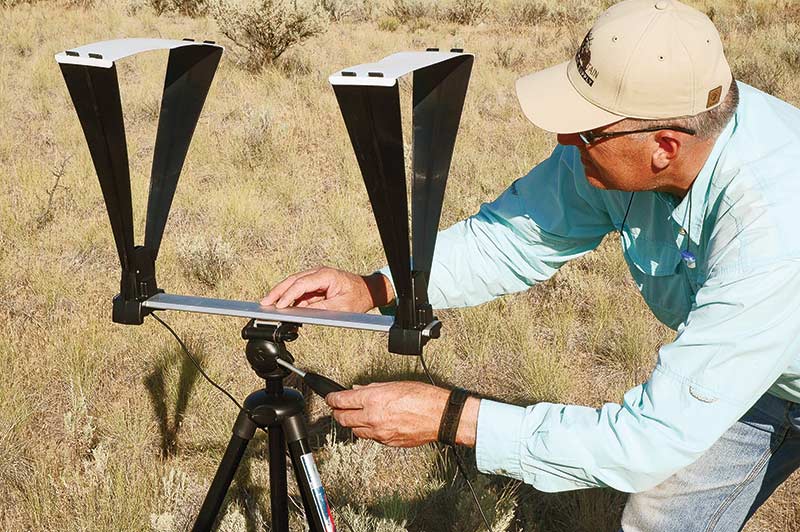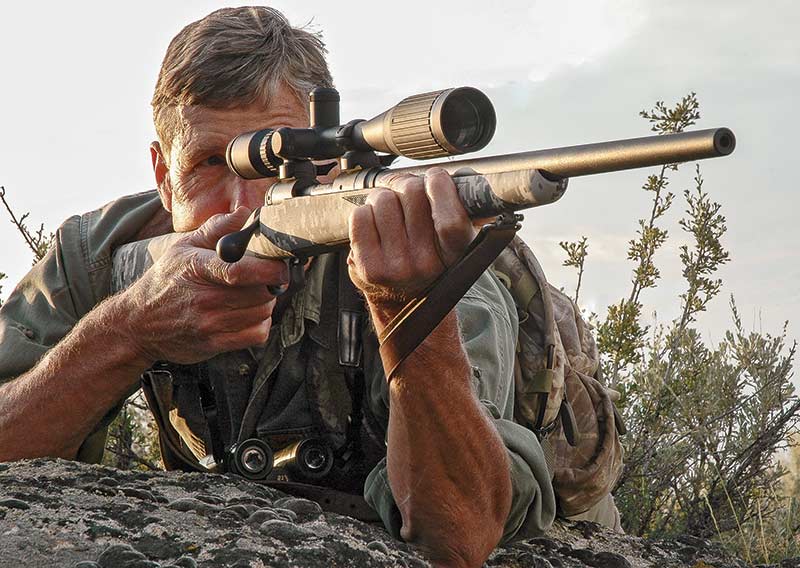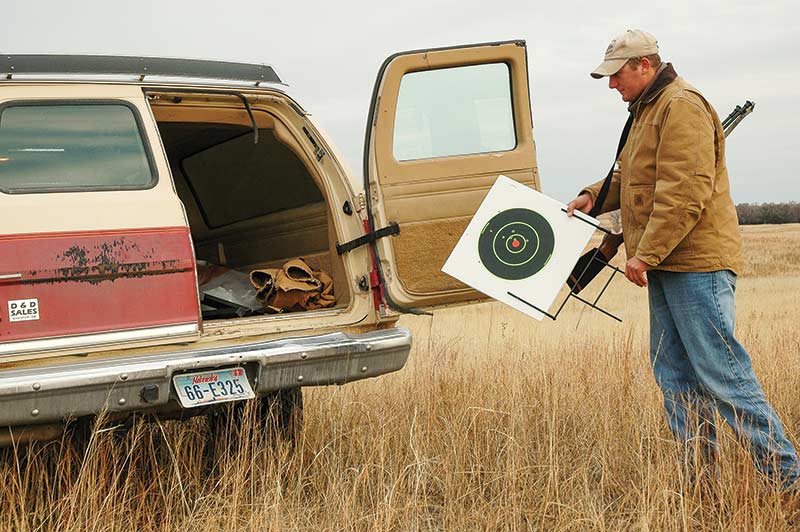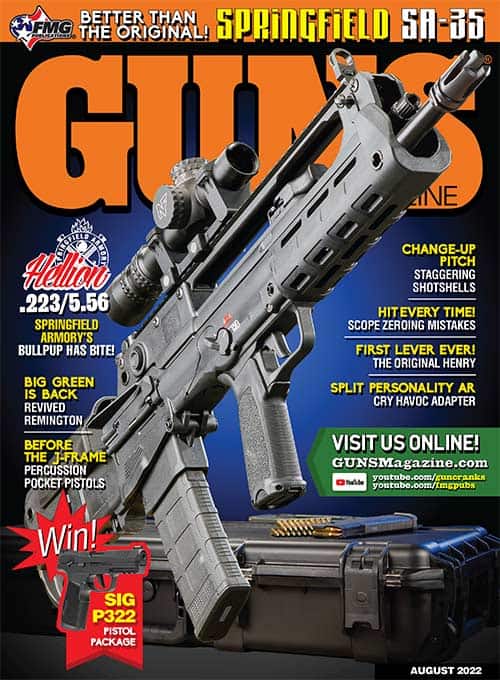Five Common Zeroing Mistakes
A simple task often done wrong
Mistake #1: Zeroing When The Rifle Isn’t Ready
Before you can zero a scope, you’ll have attached it — another topic. Bore-sighting comes next. A collimator slipped into the muzzle puts a screen in your sight line. Adjust the reticle to its center. A must for closed-breech lever, pump and autoloading rifles, it works for any. Bore-sighting saves ammo by putting first shots “on paper.”
Now grab some ammo …. No! Wait! Did you check the screws? Whoa. You’re already ahead of yourself. Scope base screws may be inaccessible; not so with ring screws and the rifle’s guard screws. Instead of “feeling” them tight, get a torque wrench from Brownells to ensure correct, even tension. Cinching the base to the rifle, I bring 6-48 screws to 25 inch/pounds. Leupold advises 8-40s be snugged to 28 in/lbs, about 20% tighter. Weaver specifies 30 in/lbs for the crossbolt on 1″ Tip-Off rings, a tad more for 30mm rings. Talley suggests 30 in/lbs for the base screw of its vertically split rings, 20 for the top screw. For 10-32 screws in its QD mounts, the numbers are 35 for the bottom, 20 on top.
I snug the rifle’s front guard screw to 45 in/lbs, the rear screw to 30. You can cinch both to 60 in/lbs if the action is glass- or pillar-bedded, or has an alloy spine. Center guard screws are best coddled. I hold torque to 15 in/lbs. Muscling a center screw can bind a bolt, even spring an action.
Now check the bore-sighting again, thankful you didn’t waste ammo by firing with loose screws.
Mistake #2: Using Small Backers And Small Targets
Bullets that don’t make readable holes are useless. At the range, use big target paper or cardboard to catch all shots. On such backers I tape quarter-sheets of typing paper, setting one backer at 35 steps, the other at 100. The first bullet at 35 should hit near center. I adjust with W&E dials to put the next spot-on, then fire at 100 and adjust to hit 2-1/2″ high. After a reasonable three-shot group, I move the 35-yard backer to 200 and adjust for a center hit.
Why a generous target? You can use a scope of modest magnification, as you will afield, but tiny targets make you crank up scope power. While point-of-impact change between settings has largely been eliminated with rear-plane reticles, and isn’t an issue with front plane, using high-power glass at the range denies you a look at targets and other distant objects as they’ll appear on a hunt. One reason many hunters over-estimate distance to game is they’re accustomed to peering through scopes near the top of their power range. Lower settings make animals look small! At least finish zeroing with the dial at 4x!
Objections to big targets are based on the belief you must have a point at which to aim. Not so! In iron-sight rifle competition, shooters can’t see the X-ring. They trust their eye to center the much bigger “black.” For scoped hunting rifles, a saucer-size target works fine to 200 yards. The reticle won’t hide it; your eye is quite capable of finding its center. With 4x scopes I’ve shot half-minute knots on such targets.
Mistake #3: Assuming What You Read Is True
Not everyone lives where they can fire at 400-yard targets. So they consult ballistics charts to find proper hold-over beyond 200. A logical option. But if general news reporting hasn’t yet disabused you of pie-eyed trust, the charts should. For as long as mice have had tails, factory-loaded 180-grain bullets have exited .30-06 rifles at 2,700 fps. My Oehler, though, has clocked them from just under 2,600 to 2,835 fps (standard, not super-duper loads, 22″ barrels). Difference in 400-yard drop is nearly 5″, given the same bullet shape. If the faster load sends a sleeker bullet, the disparity can be much greater. A round-nose bullet at 2,600 fps plummets 38″; a boat-tail spitzer at 2,800 falls 23″.
Another variable, increasingly common, is the height of your sight above line of bore. Back when 2-1/2x Lyman Alaskans sat so low in Tilden mounts they almost kissed the receiver, sight-line stayed close to the bullet’s course until gravity dissolved the union. Now, soup-can objective bells and Picatinny rails put sight-lines higher, increasing its angle to bore-line. For any given first crossing, zero range then moves farther out.
To confirm a zero, you must shoot groups on paper at the named distance with the load you’ll use on the hunt. Ditto to see where the bullet lands beyond zero range.
Mistake #4: Zeroing At Too Great A Distance
The most effective zero range depends on your load and how much mid-range gap you’ll accept. “Mid-range,” by the way, is not your huckleberry. Sight-line dives farthest below the parabolic arc just beyond midway. For squirrel hunts long ago, we lads zeroed .22s at 75 yards with high-speed LR ammo. Given iron sights or a low-mounted scope, bullets hitting point of aim at 25 yards would strike about an inch high at 50 and 3-1/2″ low at 100. My range limit was roughly the zero distance — not because I didn’t know the arc farther out, but because my wobblies couldn’t keep the sight on chestnut-size rodent skulls.
Eventually a lucky poke with iron sights took a crow off a limb at 140 steps. I can’t recall where that bead was. If you spend enough time on the trigger, you get a feel for trajectory, like an archer shooting instinctively.
With modern centerfire hunting rounds, a 200-yard zero will keep bullets within three vertical inches of sight-line to 250 yards or so — farther with frothy magnums. Call this the maximum practical point-blank range. Zero farther out, and you make the mid-range gap too wide. With a 300-yard zero, your 180-grain .30-06 spitzer lands nearly 6″ high at 200. A 400-yard zero puts it over a foot high at 200; 10″ high at 300! A client after a big deer told me his .257 Weatherby shot flat enough for a 400-yard zero, so no, he wouldn’t change it. He crippled a fine buck at 150 yards. Only community effort brought it to bag.
Most game is shot closer than 250 yards. An honest 300 steps is far, 400 very far. Better to zero at 200. No thinking required for urgent shots out to 250 yards. Shade a hand’s-width high at 300.
Mistake #5: Firing From The Bench Only
You probably won’t shoot game off sandbags or a mechanical rest. When permitted time to belly down, rifle on bipod or backpack or a jacket on a rock, you get the benefit of a rest. But it doesn’t mean the bullet will fly to the same place as from the bench. Even with floated barrels, forend pressure, or the lack thereof, affects rifle behavior as the bullet leaves. I recall a hunter whose heavy rifle drilled itty bitty knots with its bipod legs in a collapsed but upright position. On a rocky slope, when a big elk came by, he had no platform for that ’pod. An awkward shot paunched the bull at 175 yards. A long follow-up ensued.
If you expect to fire from a bipod, check your bench zero with shots from prone, pressing the rifle forward so the bipod legs dig in. You’ll steady the rifle with pressure you can duplicate most places in the field. I check bench zeroes from prone with a taut sling, my preferred shooting position on a hunt. Oddly enough, looking for places to flop down has made prone shots possible on game commonly taken offhand or from a support — whitetails to Cape buffalo. Quite commonly I find a tight sling tugs point of impact to 7 o’clock, compared to shots over bags. A .300 in my rack sent bullets 8″ lower at 200 yards from a sling! Re-bedding trimmed the disparity. I took the rifle hunting with the taut-sling prone zero.
